|
Worship and Wonder by the Seaside
Puri, Orissa
by Sarah Shuckburgh
Orissa is among India’s poorest states, but it has one of its greatest temples, says
Sarah Shuckburgh
 Wisps
of smoke rose from piles of smouldering ash dotted about the
sandy courtyard. An ancient priest raked cold embers,
spreading a thin layer of grey over the pale, parched
ground. In one corner stood a crowd of several dozen men in
dhotis and hitched-up tartan lungis, some with loosely tied
headscarves. Beyond them, we glimpsed the crowds and noisy
chaos of Marine Parade, and the Bay of Bengal shimmering in
the tropical sunshine. One man noticed my husband and me and
beckoned us forward, ushering us through the huddle of men.
On a woven mat at their feet lay the corpse of an old man,
his wrinkled face smeared with red powder, his shroud
covered with flowers. Several men were arranging logs in a
careful stack. A few yards away the eldest son loitered,
white loincloth and hair still dripping after his ritual
bathe in the sea. He
was ready to light the fire which, over the next three
hours, would consume the mortal rema Wisps
of smoke rose from piles of smouldering ash dotted about the
sandy courtyard. An ancient priest raked cold embers,
spreading a thin layer of grey over the pale, parched
ground. In one corner stood a crowd of several dozen men in
dhotis and hitched-up tartan lungis, some with loosely tied
headscarves. Beyond them, we glimpsed the crowds and noisy
chaos of Marine Parade, and the Bay of Bengal shimmering in
the tropical sunshine. One man noticed my husband and me and
beckoned us forward, ushering us through the huddle of men.
On a woven mat at their feet lay the corpse of an old man,
his wrinkled face smeared with red powder, his shroud
covered with flowers. Several men were arranging logs in a
careful stack. A few yards away the eldest son loitered,
white loincloth and hair still dripping after his ritual
bathe in the sea. He
was ready to light the fire which, over the next three
hours, would consume the mortal rema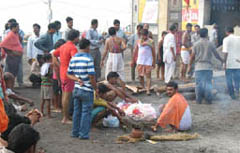 ins of his father.
Female relatives were at home, preparing ritual food for the
eleven days of ceremonies that would follow before the ashes
were thrown into the sea. ins of his father.
Female relatives were at home, preparing ritual food for the
eleven days of ceremonies that would follow before the ashes
were thrown into the sea.
Our journey through
Orissa, one of the poorest states in India, had brought us
to Puri - a unique mix of pilgrim site, seaside resort and
jostling city. Thousands of Hindus throng to Puri from West
Bengal and Andra Pradesh, but few foreigners visit. Orissa’s
tourist industry is rudimentary and inefficient, roads are
pot-holed, distances huge and hotels are often filthy. But
the region is spiritually rich, culturally diverse,
with beautiful landscapes and Orissans are open-hearted,
enthusiastic and welcoming.
 We were the only Europeans on the flight from Kolkata, and
at Bhubaneswar airport a press photographer took our picture
and asked in broken English for our names. When we arrived
in Puri a few days later, the hotel manager excitedly
pointed to a page of squiggly Oriya newsprint, each
character topped with a curved eyebrow. There, next to the
sudoku puzzle, was our photograph. We were famous! We were the only Europeans on the flight from Kolkata, and
at Bhubaneswar airport a press photographer took our picture
and asked in broken English for our names. When we arrived
in Puri a few days later, the hotel manager excitedly
pointed to a page of squiggly Oriya newsprint, each
character topped with a curved eyebrow. There, next to the
sudoku puzzle, was our photograph. We were famous!
The
government-run Panthanivas hotel was spartan and bleak, with
dangling cables, fly-strewn neon lights and peeling walls
streaked with mould. But our room overlooked the sea, and
had a basic washroom and an air-conditioning system slotted
askew into a gaping window. The hotel rarely sees Europeans,
let alone celebrities from the pages of Dharitri. Every few
minutes a knock at the door announced another curious young
man with a small bar of soap or rusty fan, mosquito
repellent or a jug of water, a towel or half a roll of damp
loo paper. Fina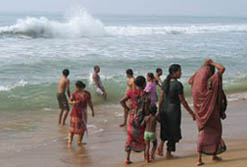 lly one brought a sheet and two stained
pillow cases, so we could make up the bed. lly one brought a sheet and two stained
pillow cases, so we could make up the bed.
The
night air was hot and humid, and before supper we joined the
strolling holidaymakers on the sea front. Rickshaws,
three-wheel taxis and motorbikes swerved through the crowds,
hooting wildly and belching exhaust. Families of five
crammed on to scooters, mothers perched sideways with saris
fluttering near the spokes, toddlers on their fathers’ laps,
clutching the handlebars, older children and babies wedged
between their parents. Marine Parade is lined with a jumble
of cheap hotels, restaurants and stalls selling souvenirs,
shells, trinkets and food. More shacks sprawl across the
beach. There are camel rides, children’s merry-go-rounds,
and strolling hawkers of candyfloss, coconuts, flags and
foil sachets of ‘pan’ – a mix of chewing tobacco and betel.
Even at nig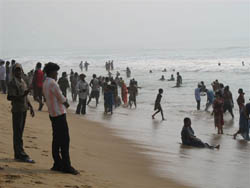 ht,
the beach was packed – mothers cooking rice and dahl on
small tin braziers, extended families crouched round
flickering lamps, children splashing in the shallows and
young women running, fully dressed, into the moonlit waves
and emerging, like Bollywood starlets, with saris clinging
saucily to their curves. The beach shelves steeply and there
are treacherous undercurrents, but local fishermen act as
lifeguards, wearing distinctive white wi ht,
the beach was packed – mothers cooking rice and dahl on
small tin braziers, extended families crouched round
flickering lamps, children splashing in the shallows and
young women running, fully dressed, into the moonlit waves
and emerging, like Bollywood starlets, with saris clinging
saucily to their curves. The beach shelves steeply and there
are treacherous undercurrents, but local fishermen act as
lifeguards, wearing distinctive white wi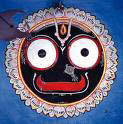 cker bonnets and
carrying inner tubes from lorry tyres. cker bonnets and
carrying inner tubes from lorry tyres.
Escaping the crowds, we ate at Wild Grass, an incongruously
chic restaurant set in a lush garden full of statues,
gazebos and fairy lights. Puri is famous for its seafood and
we ordered shrimp curry and fried pomfret, netted by local
lifeguard-fishermen – a welcome change from the staple rice
mountains with dribbles of dahl.
But the town’s main attraction is neither beach nor seafood.
Puri boasts one of India’s holiest and most important Hindu
temples - home of Jagannath, the living god, Lord of the
Universe, and incarnation of Vishnu.

The industry surrounding Jagannath is mind-boggling. Twenty
thousand locals are employed by the temple; six thousand of
them tend the living god himself in an elaborate series of
ceremonies. The Lord of the Universe is unusual-looking and
instantly recognisable
with his jet black face, circular white eyes, beak nose, and
stump arms. His head and trunk are festooned with glittering
gold. Lord Jagannath’s day starts at 5am with ritual
seal-breakers and door-openers. The ten-foot wooden statue
is woken, offered hot milk, bathed (water is poured on to
his reflection in a mirror), dressed,
 garlanded and
breakfasted. Then he receives visitors until 1.30pm, when
the doors close and he has lunch. Dozens of different dishes
are prepared in vast quantites in the temple kitchen – the
world’s largest – and these are blessed by Lord Jagannath
and then sold to the faithful in the temple’s leafy food
market – also the world’s largest. Each day 425,000 pilgrims
have lunch here, paying 30 rupees a head (about 40 pence)
for the holy leftovers and eating in a vast open air dining
area. Later, thousands more return for supper. garlanded and
breakfasted. Then he receives visitors until 1.30pm, when
the doors close and he has lunch. Dozens of different dishes
are prepared in vast quantites in the temple kitchen – the
world’s largest – and these are blessed by Lord Jagannath
and then sold to the faithful in the temple’s leafy food
market – also the world’s largest. Each day 425,000 pilgrims
have lunch here, paying 30 rupees a head (about 40 pence)
for the holy leftovers and eating in a vast open air dining
area. Later, thousands more return for supper.
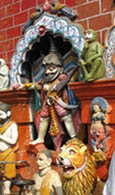
Non-Hindus are not allowed into the temple, but we strolled
round the high pink walls of the compound, pushing through a
multitude of holy men in orange robes, bare-chested
Brahmins, near-naked Vishnavite ascetics, beggars in
tattered dhotis, old women bent double, barefoot waifs,
skinny dogs, bicycles, rickshaws, impassive hump-backed
cows, and hordes of worshippers pouring in through the four
gates, past uniformed guards. Pilgrims were buying offerings
- coconuts, bananas and marigold garlands - from displays
laid out on the ground; others paused to pray at gaudily
painted shrines set into the walls. Temple employees hurried
by, balancing stacks of palm baskets on their heads or with
sacks of vegetables hung from bicycle crossbars.
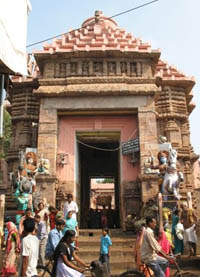 Stretching
away from the main ‘Lion’ gate, near the crumbling palace of
Puri’s Maharaja, is Bada Danda, the wide, straight road on
which, once a year during the monsoon, the famous Rath Yatra
festival is held. On the day of the full moon, the statues
of Jagannath, his brother Balbhadra and sister Subhadra
receive ceremonial baths and then retire from public view
for fourteen days to convalesce. Rested and refreshed, the
gods are installed on three vast wheeled platforms – the
original ‘juggernauts’ – and dragged by thousands of men to
the Gundicha temple two miles away. Here the trinity enjoy a
lakeside holiday before being hauled back to the main
temple. The richly decorated chariots are then dismantled
and used as firewood. When we were there, the road was
bustling with pilgrims and souvenir shoppers, but at Rath
Yatra, a crowd of seven ‘lakhs’ gathers - 700,000 filling
every roof, balcony and inch of tarmac. Stretching
away from the main ‘Lion’ gate, near the crumbling palace of
Puri’s Maharaja, is Bada Danda, the wide, straight road on
which, once a year during the monsoon, the famous Rath Yatra
festival is held. On the day of the full moon, the statues
of Jagannath, his brother Balbhadra and sister Subhadra
receive ceremonial baths and then retire from public view
for fourteen days to convalesce. Rested and refreshed, the
gods are installed on three vast wheeled platforms – the
original ‘juggernauts’ – and dragged by thousands of men to
the Gundicha temple two miles away. Here the trinity enjoy a
lakeside holiday before being hauled back to the main
temple. The richly decorated chariots are then dismantled
and used as firewood. When we were there, the road was
bustling with pilgrims and souvenir shoppers, but at Rath
Yatra, a crowd of seven ‘lakhs’ gathers - 700,000 filling
every roof, balcony and inch of tarmac.
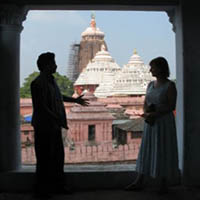 We
climbed a flight of stairs to a stifling library with a few
dusty books in grimy glass-fronted cabinets. From a verandah
we could look over the temple complex, which dates from the
Kalinga dynasty of the 12th century. Lord Jagannath and his
siblings live in the main temple (at 214 feet, the tallest
in Orissa), its pinkish stone walls intricately ridged and
dimpled beneath fluttering flags. Other smaller beehive
domes, gleaming white with red trim, celebrate lesser
deities. Worshippers streamed up and down temple steps or
crouched in the shade of banyan trees. Smoke billowed from
the huge, blackened kitchen block. In paved courtyards,
cross-legged cooks chopped vegetables; others, bent low,
swept with short besoms, sluiced the ground with water, or
carried baskets of food in and out of the sweltering
kitchen. We
climbed a flight of stairs to a stifling library with a few
dusty books in grimy glass-fronted cabinets. From a verandah
we could look over the temple complex, which dates from the
Kalinga dynasty of the 12th century. Lord Jagannath and his
siblings live in the main temple (at 214 feet, the tallest
in Orissa), its pinkish stone walls intricately ridged and
dimpled beneath fluttering flags. Other smaller beehive
domes, gleaming white with red trim, celebrate lesser
deities. Worshippers streamed up and down temple steps or
crouched in the shade of banyan trees. Smoke billowed from
the huge, blackened kitchen block. In paved courtyards,
cross-legged cooks chopped vegetables; others, bent low,
swept with short besoms, sluiced the ground with water, or
carried baskets of food in and out of the sweltering
kitchen.
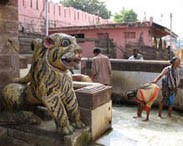 We returned to the beach to cool down in the sea. Pale crabs
were scuttling out of holes at the water’s edge. Puri faces
due south, and the sun rises along the beach to the left and
sets along the beach to the right. As dusk fell, I paddled
in the lapping waves and imagined generations of families
throwing ashes into these welcoming waters. We returned to the beach to cool down in the sea. Pale crabs
were scuttling out of holes at the water’s edge. Puri faces
due south, and the sun rises along the beach to the left and
sets along the beach to the right. As dusk fell, I paddled
in the lapping waves and imagined generations of families
throwing ashes into these welcoming waters.
www.industours.co.uk
First published by the Telegraph
©SarahShuckburgh |